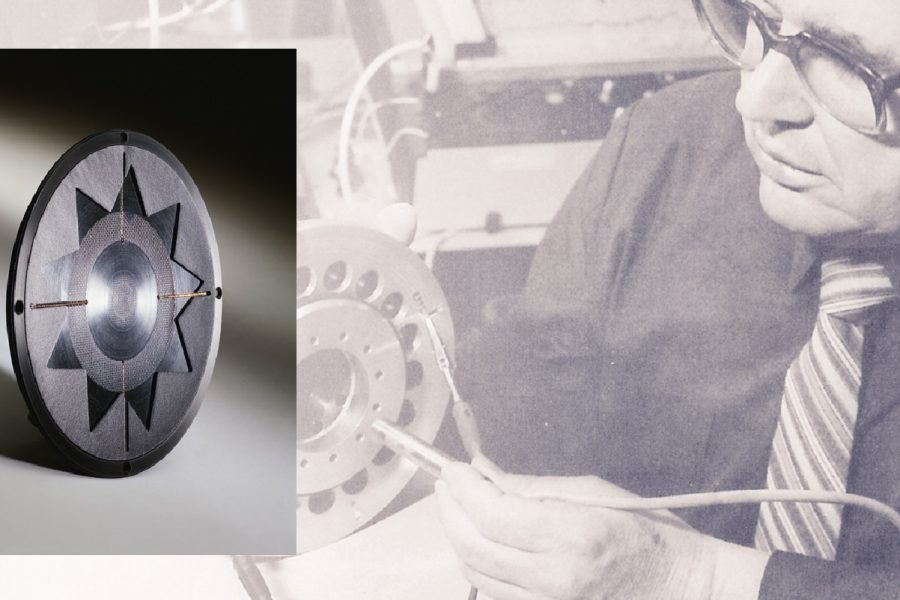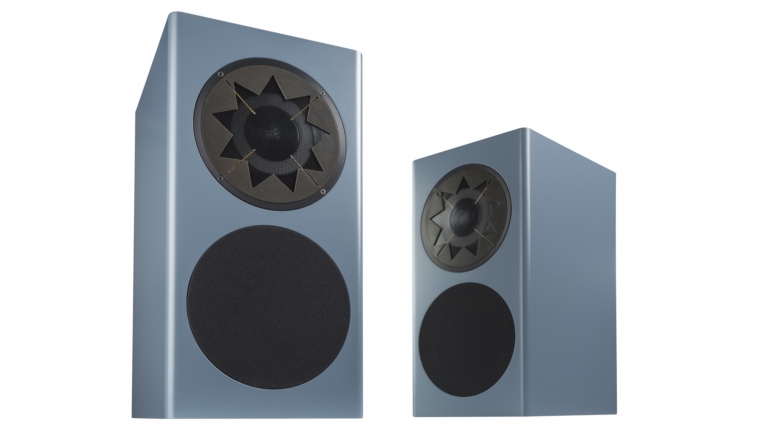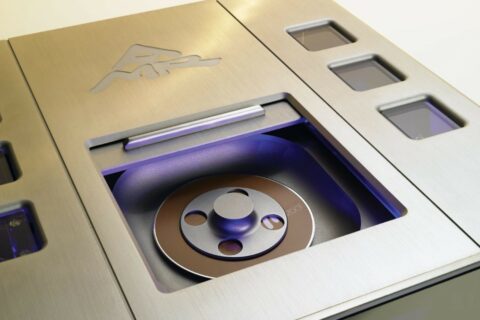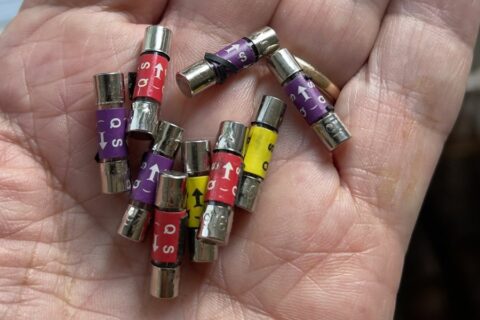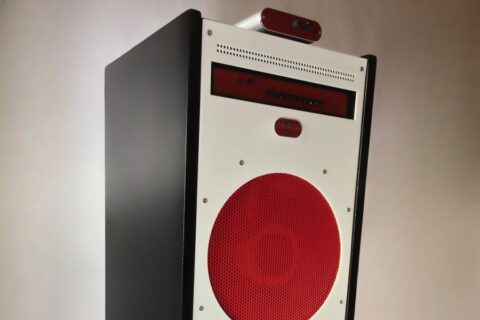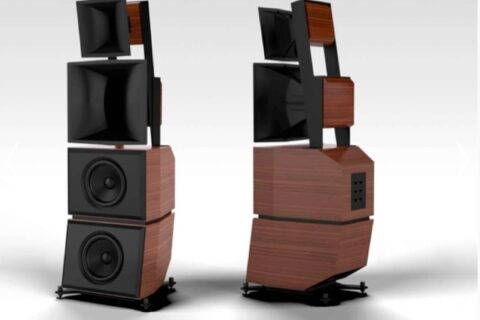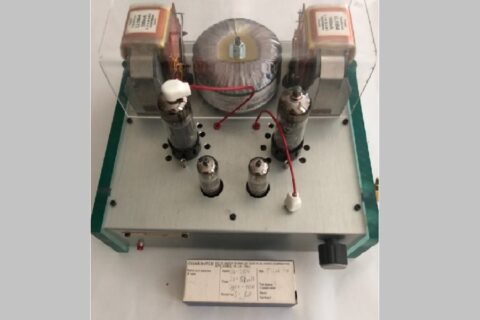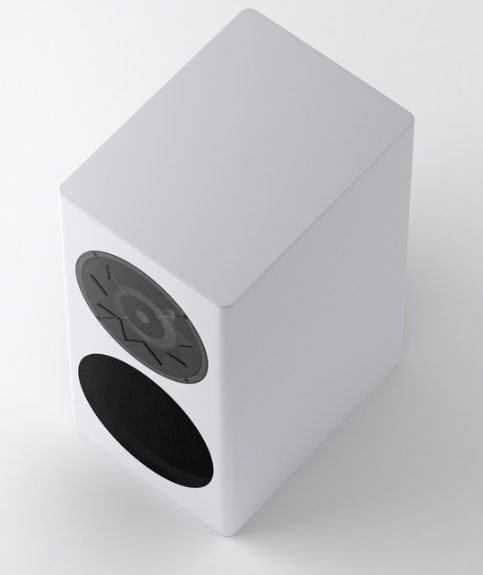 I remember, very vividly in fact, an eminent loudspeaker designer, bored with the depressingly slow development of dynamic speakers, and how a gleam of enthusiasm grew in his eyes when the talk turned to Manger’s flat speaker unit. The reason was, obviously, that the said element offers at least some theoretically and technically new or at least unusual reflection. Quite radically different, in fact.
I remember, very vividly in fact, an eminent loudspeaker designer, bored with the depressingly slow development of dynamic speakers, and how a gleam of enthusiasm grew in his eyes when the talk turned to Manger’s flat speaker unit. The reason was, obviously, that the said element offers at least some theoretically and technically new or at least unusual reflection. Quite radically different, in fact.
He was an engineer, so I can understand his reaction. But even not taking into account his background, I think he was right, acknowledging that conical dynamic drivers that can (together) cover the whole frequency range have existed for almost two thirds of a century now, and that nothing extraordinarily unusual has happened since their emergence, resulting in, as we now know, a situation in which a vast majority of the loudspeakers on the market sport standard traditional dynamic drivers with cones and voice coils, and what have you.
Where a dynamic element selects the microphone diaphragm as its reference, and reproduce the recovered signal, the information, as unaltered as possible, the element designed by Josef W. Manger, originally in 1978, takes as its reference the basiliar membrane of a human ear.
I do not know any theoretically necessary reason why the basilar membrane would be a better reference for the speaker element design than the microphone diaphragm. Nevertheless, there are certain similarities between the Manger element, the sound transducer as they call it, and the ear membrane. First off, the membrane of the Manger element is flat, not a cone. Second, the diaphragm does not move like a dynamic element as a piston (i.e. is not a cylinder), but wavyly and concentrically radiating from the middle to the edges.
Thirdly, the rigidity of the thin membrane increases from the center toward the edges according to a particular formula (at an equal ratio) so that the high frequencies are rapidly attenuated while the lower frequencies continue to travel until they are attenuated by a star-shaped absorber with no peripheral reflections. 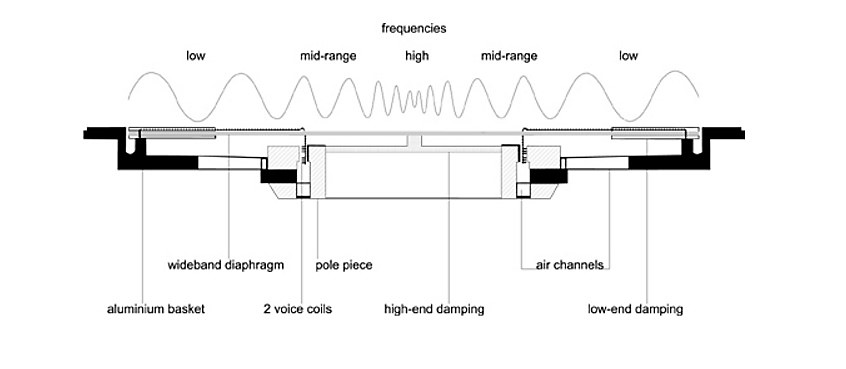
A number of exceptional solutions have been made to make the driver work according to its ideal model. The manufacturing process of such an element requires very small tolerances of 0.008 mm. Why did Manger want to build such a difficult-to-implement element? The same reason what the manufacturers of electrostatic speakers or widebandwidth drivers refer to: reluctancy to divide the frequency range between more than one element, which, for Manger, implies timing and transient errors.
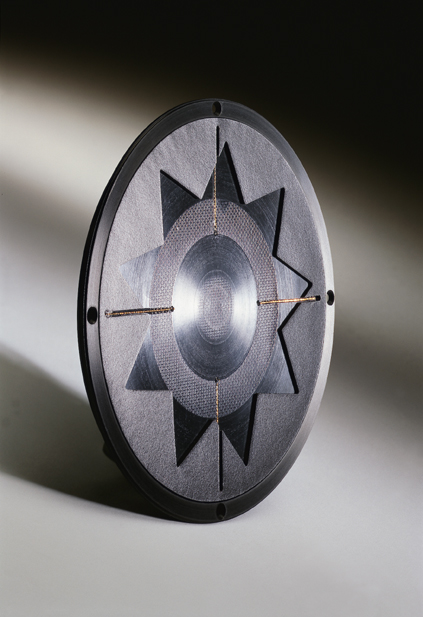 Manger’s driver can alone reproduce frequencies from 80 Hz to 40000 Hz, i.e., apart from the two lowest octaves the entire hearing range plus an octave on top of that. The active diameter of the diaphragm is 19 cm, but the higher the frequencies go, the smaller the effective surface area relative to the wavelength to be reproduced.
Manger’s driver can alone reproduce frequencies from 80 Hz to 40000 Hz, i.e., apart from the two lowest octaves the entire hearing range plus an octave on top of that. The active diameter of the diaphragm is 19 cm, but the higher the frequencies go, the smaller the effective surface area relative to the wavelength to be reproduced.
Regardless of its wide range, the element’s sensitivity is commendable 91 dB 1W / 1m. Also, the reported rise time is respectable: 13 μs. This has been achieved with a very light, 70mm diameter voice coil, where two coils are mechanically mounted in series, but electrically in parallel. The excursion is ± 3.5 mm and the mass only 0.4 g. The solution is said to reduce non-linearity and natural resonances.
The membrane of the element is not rigid in the conventional sense; it is flexible enough to provide a frequency-independent impedance for the amplifier, and as a result, no extra energy is stored in the system. This, for Manger, is essential for optimum transient playback. The membrane is put into motion by a total of 15 x 1.32 Tesla neodymium magnets with an air gap of only 0.95 mm.
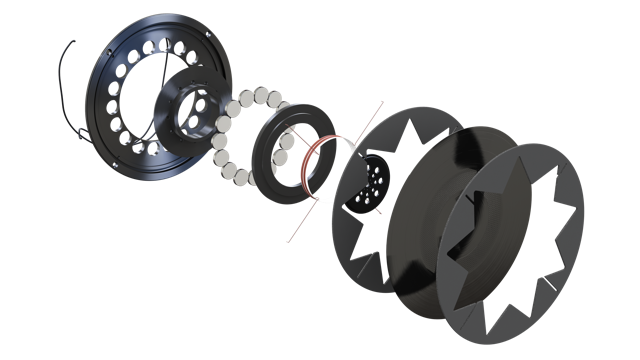
Small only in size
The fs is 88Hz. Properly loaded, the element should alone be able to provide a nice amount of bass. In fact, if I remember correctly, Manger had such a model at some point in the past, a tall floor stander with one Manger element high up.
However, the element is not a classic 7-incher (for some reason, Manger speaks of 8 incher) widebandwidth driver in the true sense of the word (Fostex’s famous 4-incher has fs = 78Hz), which would reproduce seemingly all octaves at once. Therefore, it is no wonder that Manger, in its existing loudspeaker models, such as the Z1, matches the driver with a (8-inch) dynamic bass unit.
The woofer is crossed at 360 Hz, meaning that the 3-4 lowest octaves are left on the shoulders of the woofer, in itself a fairly traditional dynamic element with a sandwiched carbon fiber / paper cone, and 42mm voice coil. The element is bolted to a sealed enclosure.
The Z1 is a clean-looking well-finished compact speaker, but not a little box. The height is 534mm (x 270mm x 364mm) and the weight 26kg per piece! One of the advantages of the flat Manger element is that even without the grill it looks unobtrusive, not too technical. Not glamorous, but convincing.
The speaker terminals are WBTs. Biwire-bridging with jumpers.
Customers can choose their own finishing eg. from many veneering options. The Z1 also has its own (optional) stand (silver or black) that puts the speaker at an optimum height. Underneath the massive bottom plate are spikes.
With music
First things first: the sound of the Manger Z1 has a number of excellent features. For instance, it’s almost disturbing how self-confidently and fairly, in a right-heartedly balanced way the speaker plays music regardless of the pieces’ frequency distribution.
Even more startling is the ”dryness” of the sound. Manger openly has set a precise and dry sound as its sonic target, especially over the bass frequencies, and it is true that the Z1’s bass performance can be described as undemonstrative or controlled.
But by praising the dryness of the sound I do not refer to the Z1’s bass performance, nor to the lack of room reflections in the sound floating over to the ears. As for the latter, during the listening sessions, the speakers were placed clearly out of the front and side walls making the conditions for a good sound quality better than on average. I then tested, with a number of familiar and relevant music samples, the speaker’s tendency to raise room modes, the result always being the same: as little as possible. The conclusion? These loudspeakers (the Manger driver?) interact with the room in an unusual way.
By “dry” I mean, however, that something was missing from the sound, something that the ear/brain is accustomed to hear on very many other loudspeakers. Intuition tells that “that something” is something that is not supposed to be exposed to the ear in the first place. Some extra liveliness, some extra color or some other extra quality, not easy to articuate what exactly. The point is that one gets a strong feeling that the sound, at the risk of sounding banal, only or almost only includes what is on the record, nothing added to it. A buzzling and uncommon experience indeed, but also highly rewarding.
I guess it’s for the same reason that the Manger Z1 is, in principle at least, suitable also for studio work in near-field listening. However, my better judgment is that for studio purposes the Z1 is far too subtle sounding, and does not respond to studio professionals’ typical demands concerning the “grayness” of the tone and misunderstood brightness.
Lack of a separate tweeter could be of some concern, given how some of the widebandwidth drivers, including smaller ones than the Manger element, are inclined to reproduce high frequencies smoothly and coherently but leaving something unfulfilled. Compared to these, the Manger’s ”tweeter” does not appear to leave anything out, and instead produces a very cool, homogenous and natural treble up to respectable highs.
The presentation may seem somewhat “dark” (for want of a better term) but it is not dark or matte or round in the sense we normally understand the terms in the context. It’s all about expression and style. The treble produced by the Manger unit, like it or not, must be one of the most exciting trebles on the market, and it makes many music, whether vocal, string, piano or orchestra, sound exceptionally right and sensible. Even electric guitars.
Manger itself associates the feature with transients, the correct reproduction of which in their opinion is the absolute prerequisite for hearing the sound right. Here’s Manger: “A perfect impulse behavior without any transient errors, whatsoever! The incoming signal is converted directly into sound. Initial transients from vocals and instruments are reproduced with absolute dead-on precision…” When I read that I thought that’s the way to verbalize the subjective impression.
Pure transient playback is reported also to do with the speaker’s imaging capability. Manger is here pointing to the listener’s difficulty in locating the sound in the loudspeaker cabinet. That’s true but I’d say the Z1 is not unique in this respect. There nevertheless is something particular (again) about the Z1’s deep and “boundless” sound stage, which doesn’t reduce down to the speaker’s smooth and unstressed treble performance, but has probably to do with speaker’s radiation characteristics. To hear the stereo effect, the depth of the sound, does not require moving one’s head or seeking a new spot on the couch, not to the same extent anyway as with many other speakers. For the same reason, the loudspeaker is not very sensitive to directing it toward the listening spot, though not entirely immune either.
The deep stereo impression, combined with the “dry” sound, could mean a sparing or housebroken sound, but in the case of the Manger Z1, this is fortunately not happening. The sound is subdued in its own mysterious way, but there is also the required presence and brilliance to keep the music lively, depending, of course, on the way the disc is recorded and the used listening volume. With CDs recorded at a low level, the Z1 (sensitivity 89dB) asked for more volume to prevent the presentation from becoming distant, yet even 15 good tube watts were good enough to do the job.
I guess the loudspeaker’s unusual way of radiating the sound is also behind its fatigue-free presentation. Pure and liquid playback of the highest frequencies also contributes to the effect. Moments when one feels like lowering the volume in the middle of the track are likely less frequent with the Z1.
The Manger unit is a virtual point source, and sounds like it too, even though the speaker doesn’t make big fuzz about it. The unit appears to be seamlessly matched with the woofer. This is certainly influenced by Manger’s decision, with regard to the level of the bass, to be a bit more on the conservative side than the opposite. For the Z1, it declares 40Hz as the lower end, and that one can confirm also subjectively. On the other hand, I have heard 40Hz speakers, which emit heftier, though not necessarily more correct, bass notes. For my own musical taste, the level of the bass in the tonal balance was quasi perfect, but I can imagine soundtracks with which a more abundant bass delivery would be aesthetically more justified.
Now the Manger Z1’s sonic plot begins to unfold. The loudspeaker is not a loudspeaker of a certain musical genre. It’s not a platitude that many music gets a happy treatment from it. But there is an idea or style of listening, characteristic to the Z1, and this is perhaps best revealed when listening to classical vocal music: the singer’s voice, the relation between the singer and the accompanying orchestra, the orchestral tones, how the various instrument groups join in, the decaying of the sounds, … just great, brilliant, … can hardly become much better than this.
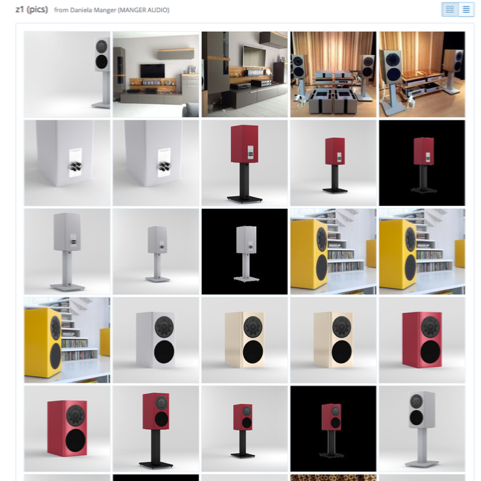
Rare quality
On the basis of its technical qualities but also the sonics alone, it is clear that the Manger Z1 is not an ordinary 2-way standmount speaker for beginners. To this date, I have yet to hear a loudspeaker that would reproduce music on the level of the Manger Z1, and would cost less to the extent that would matter financially, even though I can’t remember all the speakers that I’ve heard and reviewed over past 20 years.
On the other hand, in its own price category (c. 5000 euro), there are some very competent speakers indeed. Are there any with which the Manger Z1 could not stand a direct comparison? Matters of taste apart, hard to imagine. Different speakers possess different strengths, of course, but the Z1 poses a tough case. Absolutely worth trying.
As a friend of widebandwidth loudspeakers, I can easily accept the benefits of an element that by itself pursues to cover a major part of the frequency range, even small resulting shortcomings, if any. With the widebandwidth drivers I have tried in my own speakers (PHY, Voxativ, … and a dozen other) I’ve been aiming at a slightly more expressive and intimate presentation than what appeared to be the politics of the Z1, but in the end of the day I had to admit that the Z1’s argument in favor of its own performance style was very strong!
Comparing listening experiences and observations over time is an unrewarding exercise, if not impossible. Also, before this review there was a dry period of two months without reviewing duties, and not being able to hear my dear test music samples. Having said that, I will not immediately remember another loudspeaker regarding which my linear notes would have had as many “One of the best performances ever?” markings.
PS Since July all Manger models come with an upgrade. This includes internal wiring with Furutech cabling, passive speaker models get better crossover parts and improved damping and active speakers get AHP fuses. The result, according to Manger, is “more coherence, more structure and the core performance of the Manger sound transducer benefits with an improved transient resolution”.The costs of the upgrades are EUR 1000 per pair for the passive models, EUR 1500 per pair for the active speakers.
Specifications of the MANGER Sound Transducer:
Frequency range: 80 Hz – 40 kHz
Rise time: 13 µs
Sensitivity 1W/1m: 91 dB
max. SPL cont./short term: 110 dB / 116 dB
Recommended power: 10 W – 400 W
Impedance: 4 Ohm / 8 Ohm
DC resistance: 4,2 Ohm / 7,1 Ohm
Free air resonance frequency: 88 Hz
Induction B: 1,32 T
Voice coil inductance: 27 µH
Air gap energy: 560 mWs
Air gap volume: 1043 mm3
Air gap height: 5 mm
Air gap width: 0,95 mm
Voice coil diameter: 70 mm
max. excursion: ±3,5 mm
Dimensions: ø 210 mm x 22 mm
Weight: 1,2 kilograms
Handmade in Germany


